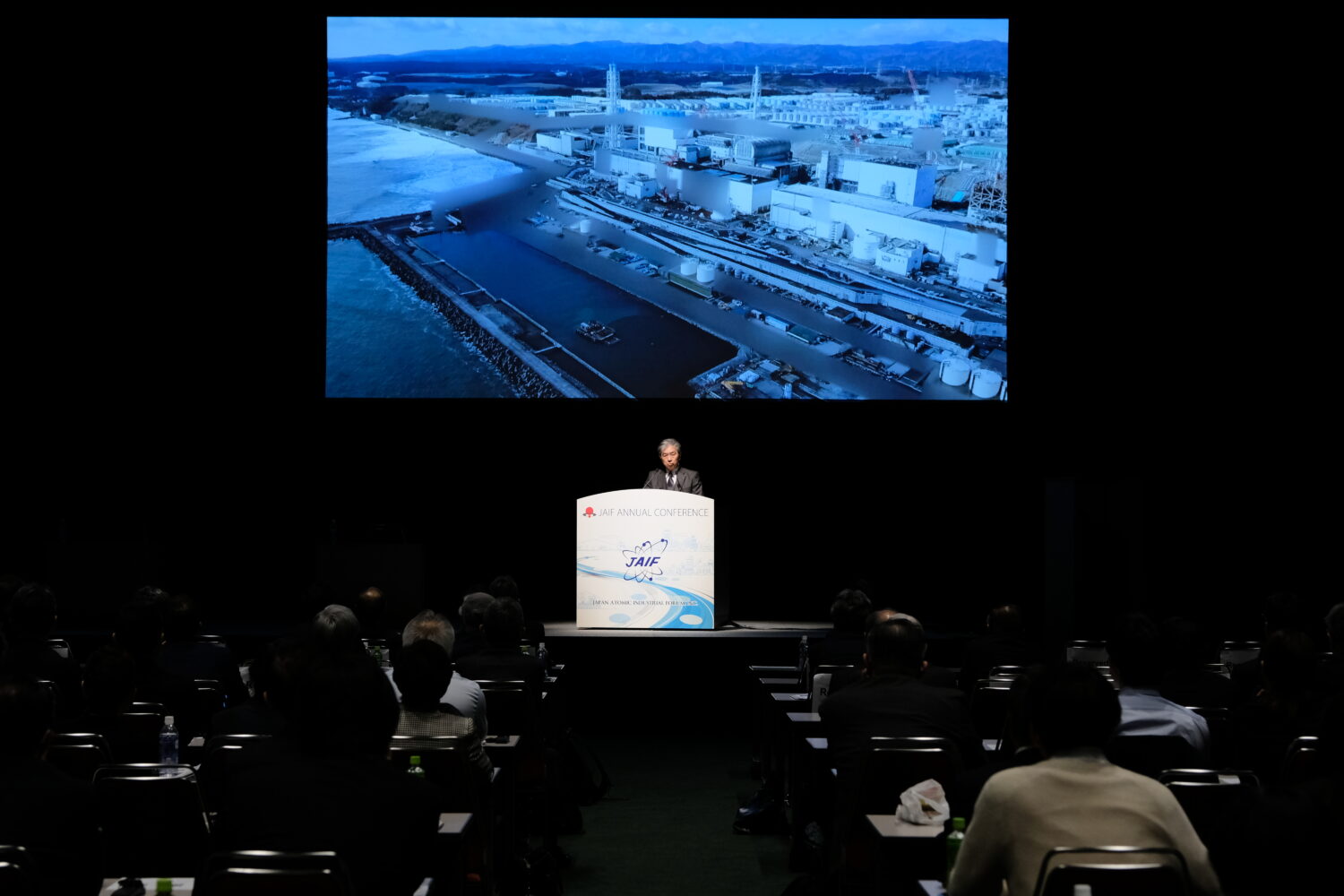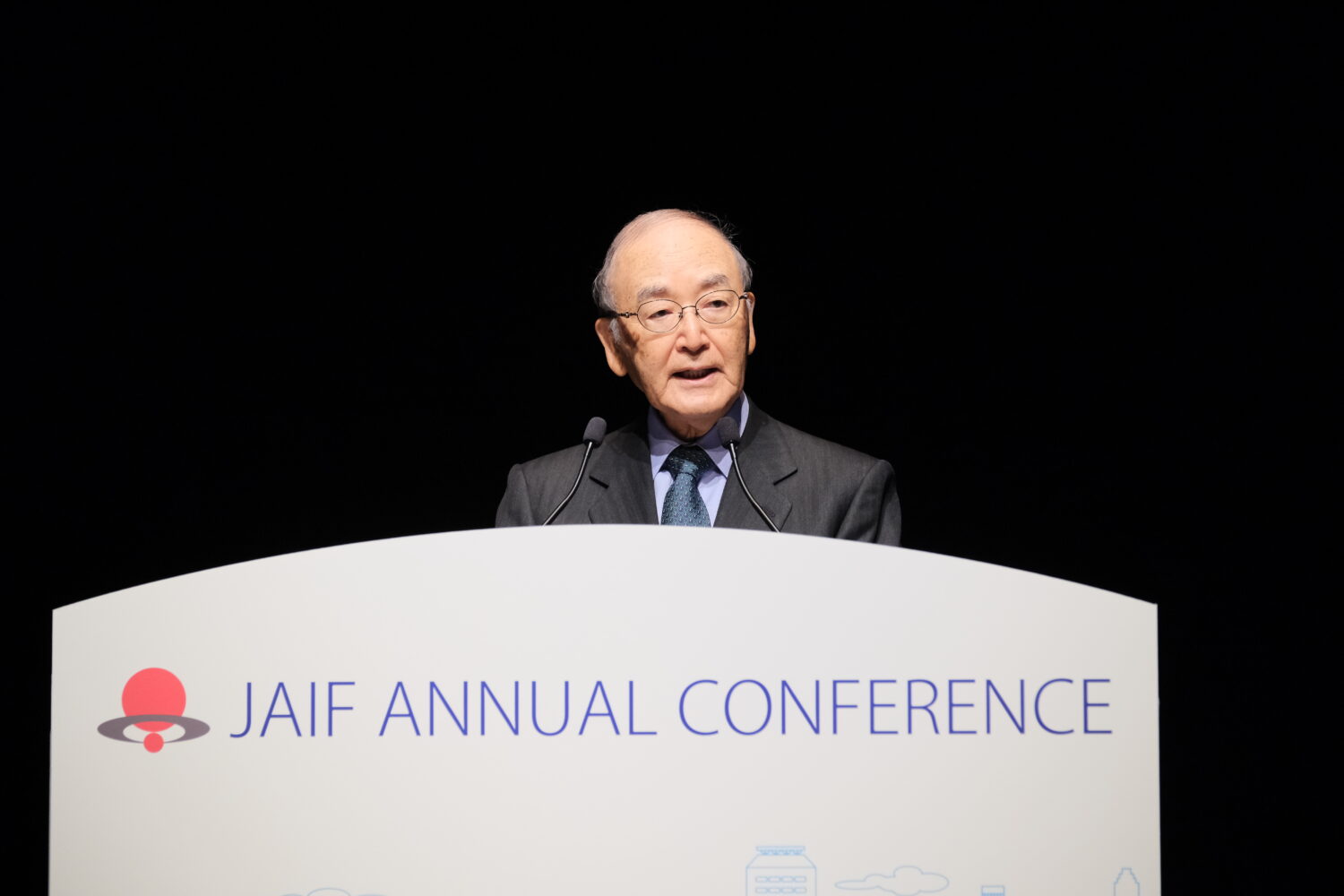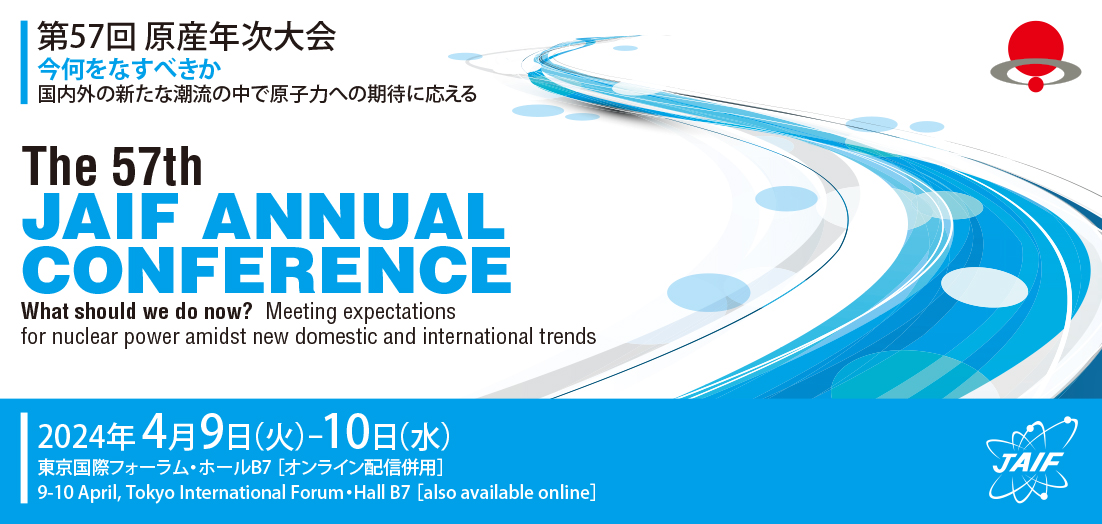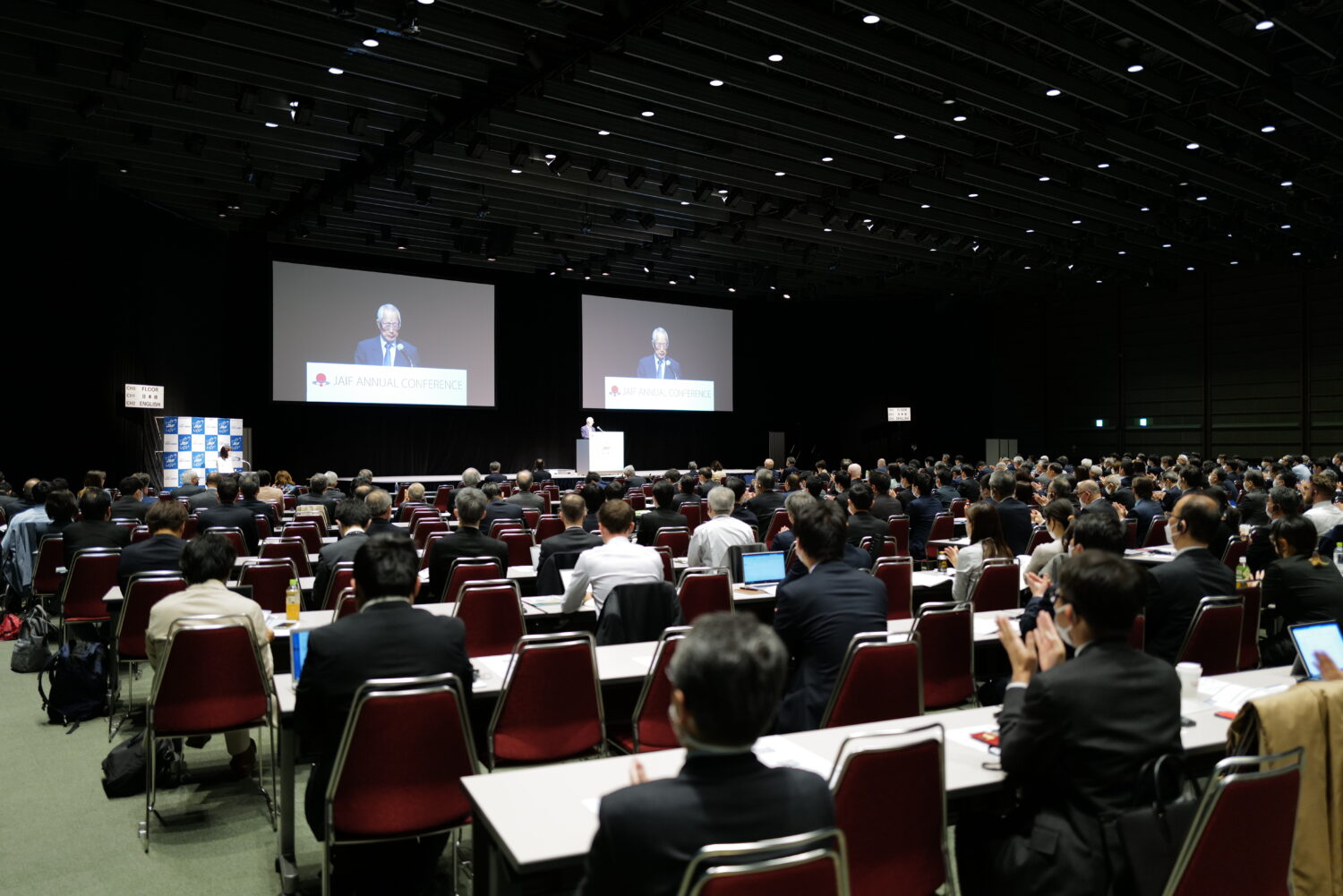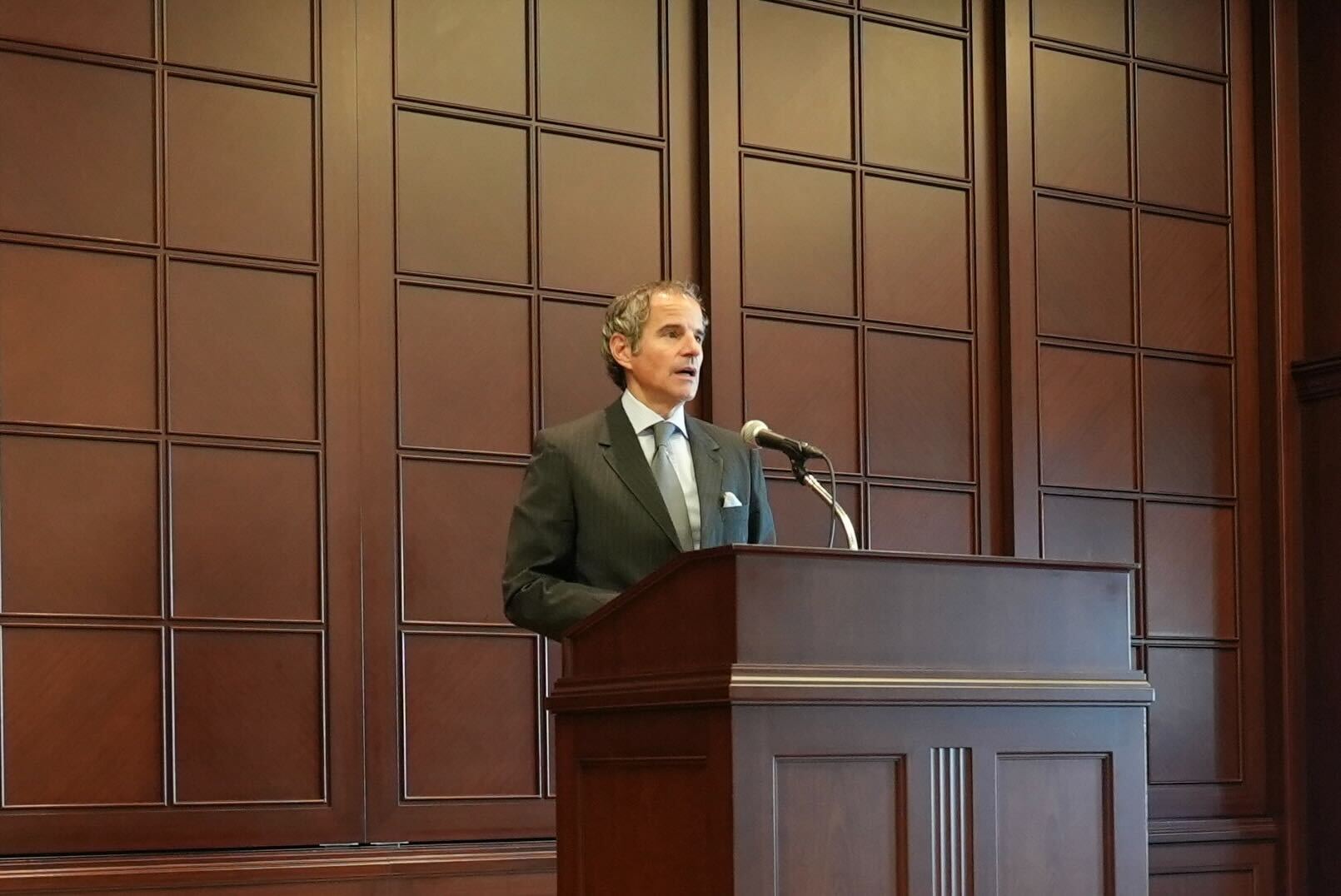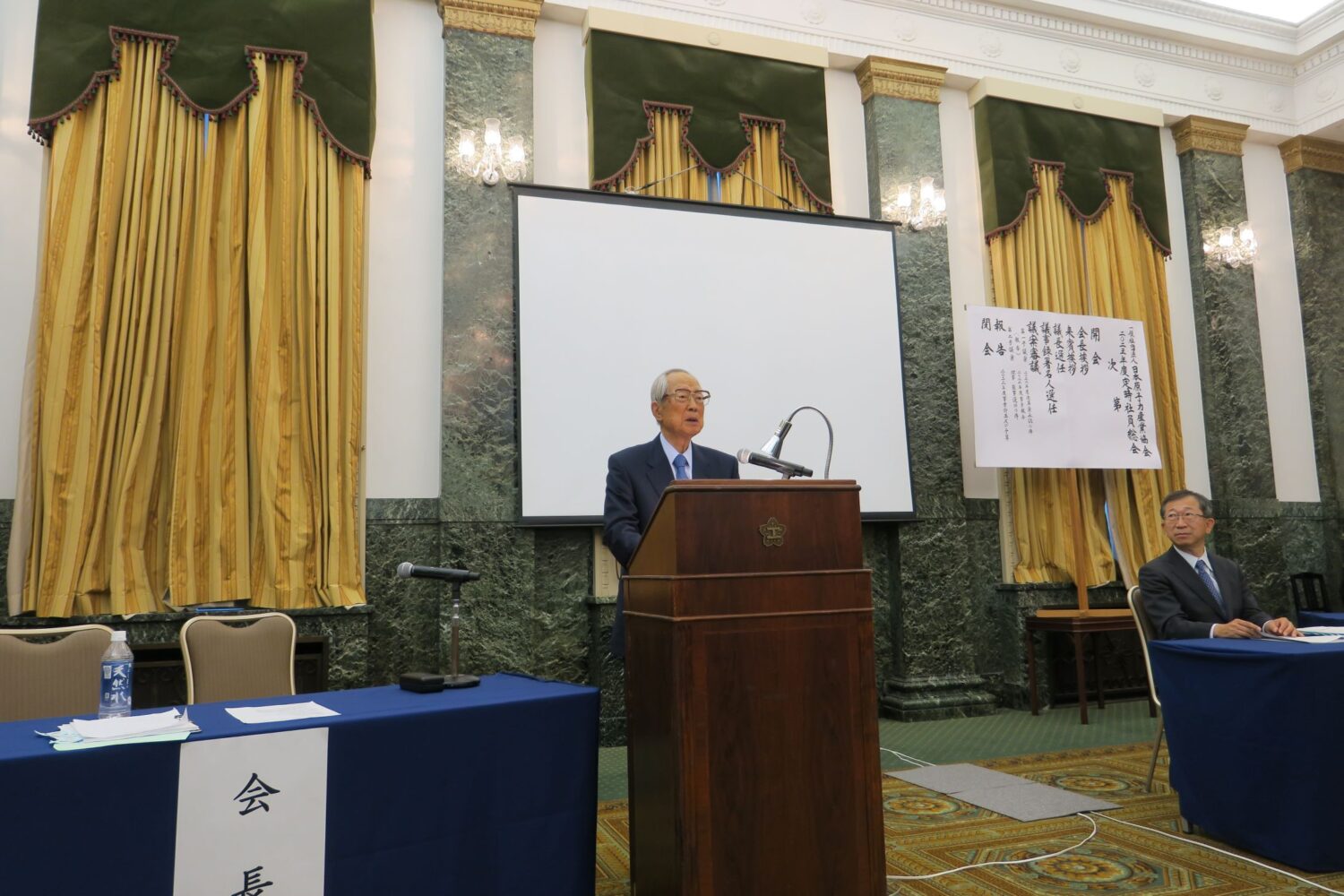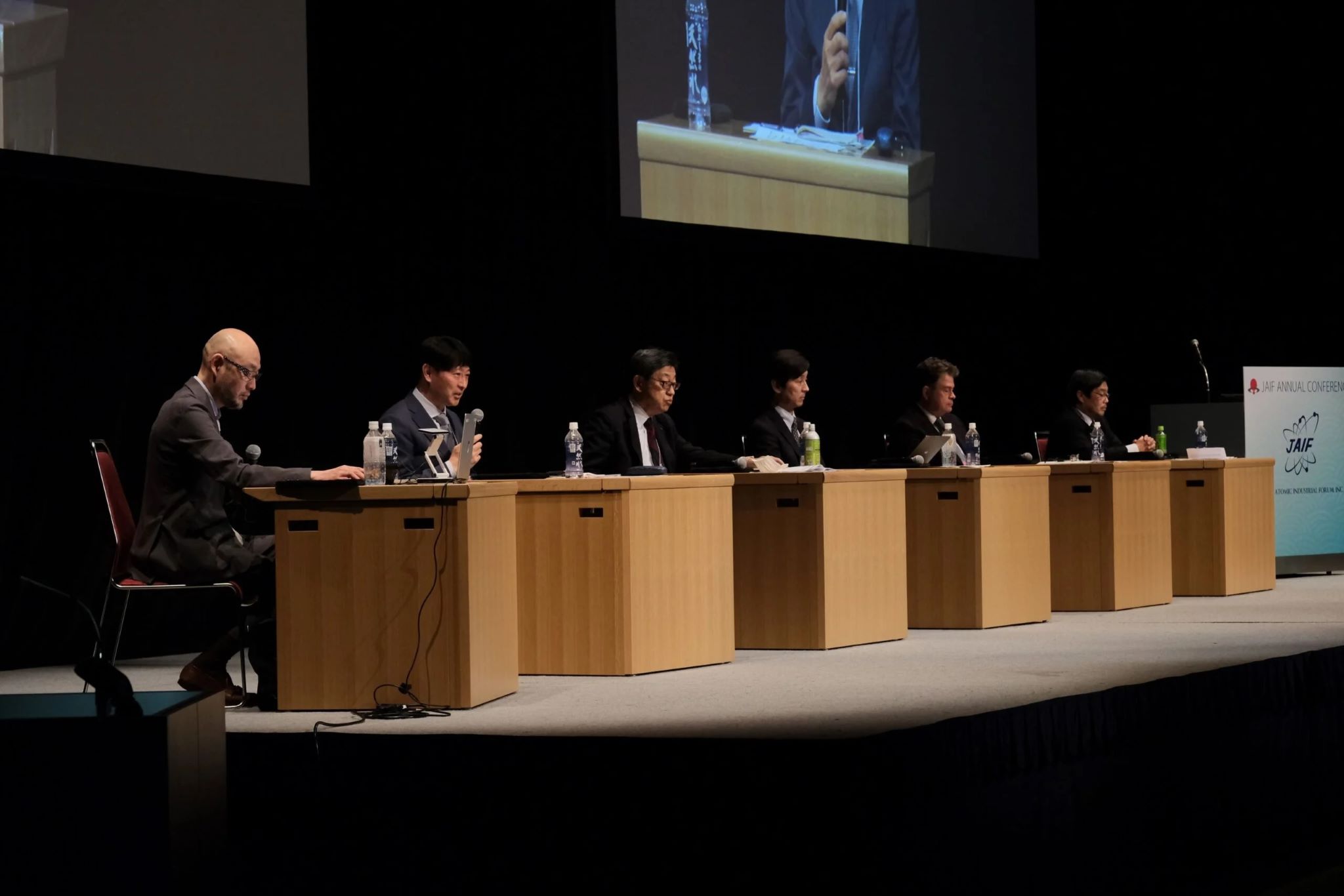Previously, Session I of this year’s conference examined the topic of “Global Challenges Toward a Decarbonized Society.” Next, Session II looked at the reconstruction of Fukushima, which is indispensable if policies on energy and nuclear energy are to be successfully carried forward.
Building on the discussions in the first two sessions, Session III turned to what Japan should do now. Moderator Ichikawa asked, “What kind of energy vision should Japan have, and what should the Japanese nuclear industry do to fulfill it?” The panelists then discussed those questions by citing examples from other countries that are more advanced than Japan in terms of eliminating emissions.
Ichikawa noted that Japanese thinking had not yet caught up to other countries as far as carbon neutrality was concerned, saying, “Globally, climate change measures are not seen as costs, but rather as part of a growth strategy.” Pointing to the emphasis on ESG (environmental, social and corporate governance) by the financial community as well, he struck a note of warning that those industries neglecting ESG would find it difficult to obtain financing in the future.
 Summary of Remarks by UNECE Director Scott Foster
Summary of Remarks by UNECE Director Scott Foster
First, a presentation was made by Director Scott Foster of the Sustainable Energy Division of the United Nations Economic Commission for Europe (UNECE). Noting that a stable supply of energy was at the heart of the seventeen Sustainable Development Goals (SDGs) of the UN, he voiced his recognition that nuclear power was essential in a shift to zero-emission power sources.
His remarks were as follows:
“Climate change is no longer a prediction, but an ongoing reality. The average global temperature has already risen by 1℃, and it will be quite difficult to hold the rise to within 2℃ in the near future. All possible measures must be taken now.
In analyses by the United Nations Economic Commission for Europe (UNECE) conducted for ECE member countries, three scenarios were addressed: (1) a reference (REF) scenario, where no climate measures are taken, (2) an NDC scenario, where each country sets its own goals, and (3) a P2C scenario, where serious efforts are made, holding the temperature rise to within 2℃, per the Paris Agreement. It was determined that the third scenario (P2C) would require at least 90 billion tons of CO2 to be cut or captured before 2050.
Nuclear energy obviously plays a quite significant role, and if it is excluded, the P2C scenario cannot be completed. Carbon capture and storage (CCS), the use of hydrogen, and the like, are expensive, but they will be necessary. There is no room to exclude any technology.
First, to reduce the environmental burdens of the current energy system, guidelines need to be issued for investment in low-carbon technologies, including CCS and high-efficiency, low-emission (HELE) technologies. The greenhouse effects of methane from natural gas are also high and must be properly controlled.
In terms of reforming the energy sector, the policies now advocated by various countries are totally insufficient. Political considerations must be removed, and practical action plans for sustainable energy developed and pursued. Carbon pricing and redesigning of the market are also required. Reform of the sector can be achieved pragmatically with sustainable changes in economic, societal and environmental aspects.”
 Summary of Remarks by NIA Chairman Tim Stone
Summary of Remarks by NIA Chairman Tim Stone
Next, Chairman Tim Stone of the UK Nuclear Industry Association (NIA) gave a presentation entitled “No Nuclear, No Net-Zero.” He strongly urged that we act now toward net zero, not least for the sake of our descendants.
His remarks were as follows:
“Most electricity in the UK is still provided by fossil fuels, and much of the country’s primary energy is also fossil. The situation shares many points in common with Japan’s.
The components of Japan’s energy mix are mostly fossil fuels, with some nuclear power and some hydropower. For Japan, that presents many energy-security risks: dependence on other countries for most fossil fuels, and dependence on sea lanes for fuel transport.
In order to reach net-zero in greenhouse gas emissions by 2050, Japan, like the UK, will have to replace fossil fuels with other energy sources.
In particular, if there is no alternative to natural gas, there will be a great problem in energy supply. At present, the practical candidate is hydrogen, and hydrogen produced by nuclear energy (high-temperature gas-cooled reactors, or HTGRs) would be the cheapest, compared with production by other means. It would be very fruitful for Japan and the UK if they cooperated in developing advanced modular reactors and HTGRs.
The issue in that is political leadership. The current coronavirus pandemic has been unprecedented, but pales in comparison to the seriousness of climate issues. That is not a matter of markets or industry, but one of infrastructure. National governments must take responsibility for infrastructure, and leadership is essential.
The biggest issue with nuclear power may be capital costs. The cost of nuclear power is primarily a function of capital cost for the construction of power plants. Otherwise, nuclear power is competitive with renewable energies. Accordingly, governments must do something to reduce nuclear power’s capital costs as much as possible.
Low carbon is a goal essential for our future, and should be embraced immediately. Just as all countries are working together to deal with COVID-19, they must work together toward COP26. We must never forget the significance of that to our descendants. Without nuclear power, net zero is not feasible. I hope Japan and the UK will work together on the issue.”
 Summary of Remarks by NEI Senior Director Carol Berrigan
Summary of Remarks by NEI Senior Director Carol Berrigan
Next, Senior Director Carol Berrigan of the Nuclear Energy Institute (NEI), based in Washington, D.C., gave a presentation on nuclear circumstances.
Her remarks were as follows:
“Over the past year, leaders of many countries have begun acting with new urgency to deal with the dangers of global climate change. Aggressive goals have been set. The Biden administration of the United States declared a target of 100-percent clean electricity by 2035. Nuclear power is the key to resolving the issue.
Although nuclear power accounts for only 20 percent of the total generated electricity in the United States, its share of carbon-free electricity is 50 percent or higher. Especially this past year—in the middle of the COVID-19 pandemic and an unprecedented crisis of heavy snowfall in the southern United States in February—the country’s nuclear power plants (NPPs) remained in operation, demonstrating their true value. In 2020, nuclear power surpassed coal-fired power for the first time, becoming the number-two power source in the United States. Fifty-five NPPs maintaining capacity factors of 90 percent or higher generated 800TWh of electricity. Few units now generate more electricity than more units did in the past.
Energy system reform is required for countries to achieve their ambitious national goals. Nuclear power is the nucleus. National governments, NGOs and the private sector all agree that the goals cannot be achieved without nuclear power. The Biden administration has shown its determination to tackle the issue. In addition to rejoining the Paris Agreement, it convened a Leaders Summit on Climate in April to accelerate global moves. U.S. government officials also recognize the role of nuclear power.
In addition, while maintaining existing NPPs, we have to promote a swift shift to next-generation reactors. With the use of SMRs, micro-reactors and other advanced reactors, nuclear power will be multifunctional, more efficient, and available at lower cost. Advanced reactors are suitable on a variety of scales, and their output can be changed easily. They are quite compatible with power sources with inherent variability, including wind and solar power. Progress in the United States will surely spread to Japan and contribute to realizing a clean energy society.”
 Remarks by Keidanren Vice Chairman Hitoshi Ochi
Remarks by Keidanren Vice Chairman Hitoshi Ochi
Next, Vice Chairman Hitoshi Ochi of Keidanren (Japan Business Federation)—who also chairs Keidanren’s Committee on Energy and Resources—talked about energy policy and roles and issues for nuclear energy from the viewpoint of the business world.
His remarks were as follows:
“The foundation of [Japan’s] energy policy is S+3E: the conventional three “E’s” of energy security, economy efficiency, and the environment, premised by the “S” of safety. In addition, the global trend in energy and power systems is toward the three “D’s” of decarbonization, decentralization and digitalization. Japan needs to respond to that trend more firmly. The Japanese business world has lauded the goal of carbon neutrality as declared by Prime Minister Suga, and will work to realize it with all its might.
In order to realize a low-carbon society, drastic structural shifts must be made on both the supply and demand sides for energy. In addition to the decarbonization of power sources, comprehensive measures are needed— including non-electricity demand—inasmuch as three-quarters of energy consumption is non-electricity and heat. Specifically, and importantly, efforts must be carried out on the three following pillars, as addressed in deliberations by the government: (1) the electrification of energy demand and decarbonization of power sources, (2) the hydrogenation of energy demand and the mass supply of inexpensive hydrogen, and (3) the fixation and reuse of CO2, where emissions cannot be avoided.
Two months ago, on March 16, Keidanren released a policy proposal entitled “Electricity Policy to Realize Society 5.0 with Carbon Neutral,” following a first proposal entitled “Rebuilding Japan’s Electricity System,” which had been released in April 2019. The proposal first discusses future electric power systems to achieve the goal of carbon neutrality by 2050. Regarding the power source portfolio in particular, it says that all resources that are able to contribute to decarbonization must be flexibly combined, in addition to renewable energies and nuclear power. It then proposes the expansion of capacity mechanisms as a policy to develop an environment for power business, and to ensure capital for building new power-source facilities eyeing the achievement of carbon neutrality. It also proposes the utilization of feed-in premium (FIP) schemes—which provide additional payments to buffer market price volatility—as a mechanism to increase the predictability of income.
No power source option must be excluded in the power source composition for 2050. Among the many power sources available, nuclear power is an excellent choice, well-balanced on the 3Es—ensuring the energy necessary for humanity into the future—and essential for carbon neutrality. Nuclear energy should continue to be used as an important base-load power source, and maintained at an appropriate level through 2050, allowing it to play its proper role based on its supply capability. Yet, under current forty-year lifetime limits, only three current reactors will still be operating in Japan in 2050. Not only must the nuclear industry extend the operational lifetime limit of NPPs to sixty years and beyond—dealing with matters of downtime and more—but it also has to tackle the issues of replacing old nuclear reactors and building new ones.
Looking to the future, it is important also to develop technologies that both improve the safety of existing light-water reactors (LWRs) and further the development of advanced reactors that are safe and economically efficient, including SMRs and high-temperature gas-cooled reactors (HTGRs).” Since the accident at Fukushima Daiichi, the number of personnel engaged in the nuclear energy field has decreased steadily, causing great concern about maintaining the foundations of technology and human resources. National policy must be clarified as soon as possible, with appropriate inclusions in the Strategic Energy Plan.
 Remarks by Project Professor Noriko Endo of Keio University
Remarks by Project Professor Noriko Endo of Keio University
The next speaker, Noriko Endo, project professor at the Global Research Institute of Keio University in Tokyo, spoke on the subject of “Carbon Neutrality and Nuclear Energy Policy.” Now that Japan has set its sights on carbon neutrality, she said, nuclear power was clearly essential, and should be on the national political agenda.
Her remarks were as follows:
“Various councils have been set up since Prime Minister Suga made his declaration on carbon neutrality, with deliberations on carbon pricing already beginning at Japan’s Ministry of Economy, Trade and Industry (METI) and the Ministry of the Environment. This year, Japan will revise its national Strategic Energy Plan, while the Strategic Policy Committee, under the Advisory Committee for METI’s Agency for Natural Resources and Energy, is to reach a conclusion on the energy mix.
Turning our attention to other countries, the Leaders Summit on Climate was held recently [April 2021] in the United States. Other meetings to be held this year are the G7 Summit in the UK (the current presiding country of the G7), a G20 Energy Ministerial Meeting, a UN General Assembly, and the G20 Summit Meeting, followed in November by COP26 in the UK.
A political game is being played by the UK—holding this year’s presidency of the G7—and the United States under the Biden administration over leadership on climate change. What the two countries each agree on, however, is a clear political positioning of nuclear energy as a carbon-free power source, which is a different dynamic than that seen in Japan.
In Japan, CO2 emissions originating from thermal power remain extremely high. The Strategic Policy Committee has identified “nuclear power and thermal power (on the premise of CO2 capture)” and “renewable energies” as reference areas for deliberations, showing the following reference values for 2050: renewable energies at 50-60 percent, hydrogen/ammonia at 10 percent, and nuclear power combined with CCUS (carbon-dioxide capture, utilization and storage) at 30-40 percent.
At the end of 2020 and the beginning of 2021, Japan faced an extremely critical power supply-and-demand situation, with the system approaching failure. While the proximate cause was a shortage of LNG, the ultimate problem is the structural one of too few NPPs operating in Japan. With only a few nuclear plants in service, LNG has had to make up the difference.
Today, only four nuclear plants are in operation in Japan. Over the long term, NPPs will have to be retired at an increasing rate if their operating lifetimes are still limited to forty years, meaning that the drive for carbon neutrality would have to continue without nuclear power. As electrification increases, demand is expected to increase by 30-50 percent toward 2050. If NPPs are shut down after forty years of operation, nuclear power’s share would be only 2 percent. Even if the operational lifetime of reactors were extended to sixty years, nuclear’s share would be close to 12 percent in 2050, but less than 5 percent in 2060, and less than 2 percent in 2070. Facing reality, we have no choice but to consider the building of new nuclear reactors. If we want carbon neutrality, the use of nuclear reactors is inevitable.
The strong message must be the appropriate integration of the following three points into the next Strategic Energy Plan:
— The long-term use of existing reactors, with safety ensured.
— The development of innovative technology (innovation in the area of nuclear energy).
— Predictability for nuclear businesses institutionalized as a system.
The nuclear industry is one in which Japanese manufacturers are world-class, and should be protected. I recognize that the prime minister’s carbon neutral declaration as his message to us, the nuclear industry.”
 Final Remarks by President Ichikawa of Strategic Associates Japan Co., Ltd.
Final Remarks by President Ichikawa of Strategic Associates Japan Co., Ltd.
Lastly, the moderator, Shinichi Ichikawa, gave a presentation on the theme of “The Impact of Carbon Pricing.” Taking European Emission Trading (EU-ETS) as a prior example, he addressed how Japan should employ it institutionally.
His remarks were as follows:
“The archetype of carbon pricing is the European Union Emissions Trading System (EU-ETS). Prices rose sharply when the EU substantially increased its goal for cutting greenhouse gas (GHG) emissions by 2030 from the previous 40 percent to 55 percent from 1990 levels, catching the eye of the financial world.
Under the EU-ETS carbon pricing scheme, the EU sets emission allowances (caps) for each of the twenty-six kinds of fuel combustion facilities and industrial facilities which have GHG emissions above a certain scale. If a facility has fewer emissions than its cap, it can sell the balance of its allowance on the market. In contrast, any facility producing more emissions than its cap needs to buy credits on the market so as to offset the excess. If the EU uses the system to reduce the total of its emission allowances every year, it will achieve the emissions reduction goal to which it has committed itself internationally.
In December, the EU announced the European Green Deal, one of the pillars of which is the introduction of a carbon border adjustment mechanism for GHG emissions allowances. The border adjustment would be a system in which the costs to purchase emissions allowances are imposed on the price of imported products as a carbon tax whenever an EU member country imports a product from a country that does not regulate emissions.
The GHG border adjustment system was developed because of the soaring price of emissions allowances under the EU-ETS. Purchasing emissions allowances to meet the rigid regulations within the EU increases product prices. Consequently, increasing imports from countries that do not reduce GHG emissions will not benefit operators within the EU, nor will it reduce global emissions.
Carbon pricing through border adjustments is becoming a matter of interest among major countries. I have heard that the Biden administration in the United States is positive toward it. Prime Minister Boris Johnson of the UK—which has withdrawn from the EU and is the presiding country of the G7—is reported to be planning a proposal on border adjustments at the summit in Cornwall in June. In Japan, however, there is no carbon pricing. Unless the country designs a system now, Japanese industries will not be able to compete internationally.
While final costs are unclear under emissions trading—given that prices are determined in the market—emissions can definitely be reduced. In the future, that will be the mainstream way of thinking throughout the world. It may be the most rational way to work toward zero emissions at the stage of power generation while gradually increasing the percentage of electricity in Japan’s final energy consumption.
Obviously, renewable energies are important, and we need to deal with hydrogen and ammonia generation as well. Meanwhile, Germany has worked hard in that direction, but its electricity rates for households are the second highest in the EU. Despite all its efforts, Germany’s percentage of renewable energy remains at 40 percent, with coal (brown coal) at 30 percent and nuclear power at 10 percent. Germany has also built a natural gas pipeline from Russia and purchases electricity from France. That seems to be a limit.
In resource-poor Japan—despite remaining outside the global trend toward carbon pricing—the necessary composition of power sources is probably self-evident, so as to increase growth incentives and make a positive international contribution.”
Panel Discussion
The panel discussion that followed the panelists’ individual remarks focused on the best kinds of systems to support nuclear power financing, including the EU system that has been much talked about.
NIA Chairman Tim Stone stated, “The removal of risks for nuclear projects by the government would make funds flow,” while UNECE Director Scott Foster said, “Rules must be made to promote investments.”
Keio University Project Professor Noriko Endo argued forcibly, “A demonstration by the government of numerical targets for nuclear power in its Strategic Energy Plan would encourage investments by the private sector. But the government may choose to be ‘strategically silent.’ I hope we are not in for decade of ‘bluffing.’”


